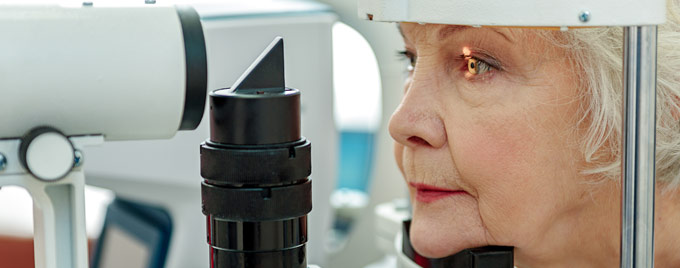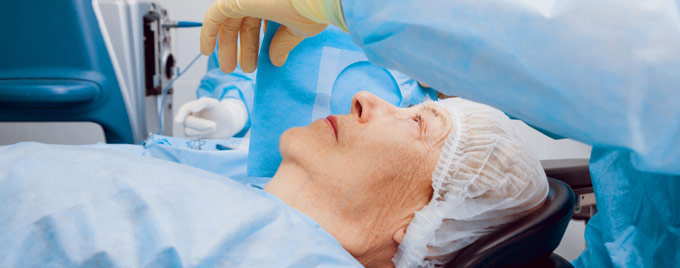Cataracts are relatively common among those over the age of 50. They refer to cloudy patches on the lenses of your eyes that develop as you get older and reduce your vision.
Cataracts can’t be effectively treated with glasses in the long term and there are no medicines or eye drops that stop them getting worse. Cataract surgery is therefore the only treatment available — it involves replacing the cloudy lens with an artificial one to restore your vision.
What happens before your cataract surgery?
Before surgery, you’ll need to see an ophthalmologist (a doctor who specialises in eye health), who will assess your eyes and vision. They’ll examine your eyes and discuss your surgery, including whether you want your artificial lenses to help you see in the near or far distance.
You may be given antibiotic eye drops to use for a couple of days before your surgery. You should let your doctor know what medications you’re taking, as you may need to stop taking them for a few days before surgery if they’ll put you at risk of complications. You’ll usually be asked not to eat or drink anything for six to 12 hours before surgery.
Cataract surgery is usually a day surgery but you won’t be able to drive afterwards, so make sure you arrange for transport home.

What type of lens is used during cataract surgery?
Your cloudy lenses will be replaced with artificial ones called intraocular lenses (IOLs). They are made of plastic, acrylic or silicone, and can be rigid or flexible. Common types of IOLs include:
- Accommodating-focus monofocal — these have a single focus and provide near or far vision but respond to movements in your eye muscles to expand the range of vision at the chosen distance
- Astigmatism correction/toric — these correct your vision if you have astigmatism
- Fixed-focus monofocal — these lenses have a single focus and provide near or far vision
- Multifocal — these lenses are similar to varifocal glasses with different areas of the lens providing different focus strengths eg near and far vision
What types of cataract surgery are there?
There are different types of cataract surgery depending in part on the type of artificial lens you will have inserted.
Phacoemulsification
This surgery involves making a small 2-3mm cut at the front of your eye. An ultrasonic probe (a device that produces sound waves) is then used to break up the cloudy lens before it’s removed from the eye and a foldable artificial lens is inserted.
Manual extracapsular cataract surgery (MECS)
This surgery involves making a 9-13mm long cut at the front of your eye to remove your cloudy lens and insert the artificial lens. As a longer cut is made, this surgery has more risks than phacoemulsification but is still a common procedure.
Manual small incision cataract surgery (MSICS)
A variation on the MECS procedure, this surgery involves making a V-shaped cut at the front of your eye, which is wider on the inside of your eye than the outside. The cloudy lens is removed through the cut and replaced with an artificial lens.
Femtosecond laser-assisted cataract surgery (FLACS)
A cut is made at the front of your eye using a laser and ultrasonic energy is used to break up the cloudy lens. The energy needed to do this is less than needed for phacoemulsification, which can help reduce the healing time after surgery.
What happens during cataract surgery?
Cataract surgery is a quick and straightforward procedure that usually takes 30-45 minutes. It’s usually an outpatient procedure performed under local anaesthetic, so you can go home on the same day.
Your surgeon will numb your eye using local anaesthetic, either using eye drops or an injection. This means that while you’ll be awake during the surgery, you won’t be in any pain or able to see what your surgeon is doing.
Your surgeon will then make a cut into the front of your eye. If you are undergoing phacoemulsification surgery, they will insert the ultrasonic probe into the cut and the probe will be used to break up the lens, which will be removed using suction.
Your surgeon will then insert the IOL through the cut and position it where your natural lens was previously. With phacoemulsification and FLACS surgery, stitches are not usually needed but they are used for surgeries that make larger cuts.
After your surgery, you will rest in the recovery area for 30 minutes to an hour before being allowed to go home.

What is recovery like after cataract surgery?
After your surgery, you should experience a significant improvement in your vision after a few days. However, it can take up to a month for your eye to heal fully, so you’ll need to follow post-surgery instructions during this time.
You may have some eye redness and blurred vision in the days immediately after your surgery but this is usually nothing to be worried about.
Your eyesight will be tested shortly after your surgery by your ophthalmologist. It’s important not to drive until your ophthalmologist tells you it is safe to do so.
The only medication you’ll need after your cataract surgery is medicated eye drops, which you’ll need to administer a few times a day in the weeks after your surgery. You should avoid using any eye drops other than those prescribed while your eye is healing.
You’ll also need to wear a protective eye shield when sleeping, usually for a week after your surgery. You should also protect your eyes while out in sunlight by wearing your sunglasses or the post-operative sunglasses given to you.
After your surgery, you should avoid the following for at least the first week:
- Activities that could cause dust or dirt to get into your eye
- Bending and exercising that could cause stress to your eye
- Heavy lifting or other strenuous activity
- Water splashing in your eyes — this increases your risk of infection
Looking after your eyes after surgery
Once you have fully recovered, it is still important to look after your eyes. As well as wearing the right prescription glasses and keeping up with your regular eye examinations, make sure you:
- Avoid smoking — this can increase the risk of eye diseases and damage your optic nerve
- Eat a balanced diet that includes plenty of fruit, vegetables and fish high in omega-3 fatty acids, and maintain a healthy weight
- Exercise regularly to help control diseases that can affect your eyes
- Follow recommended care steps if you wear contact lenses
- Rest your eyes if you use a digital screen a lot
- Wear sunglasses that block 99-100% of UVA and UVB radiation

